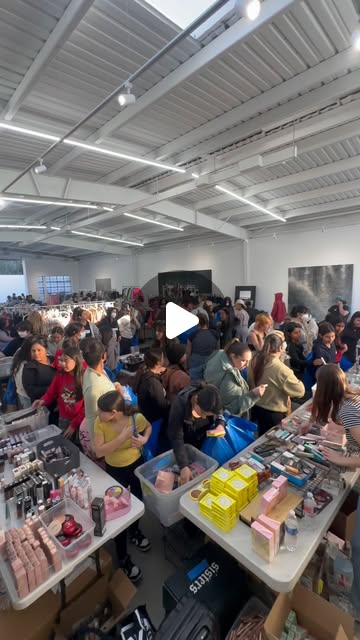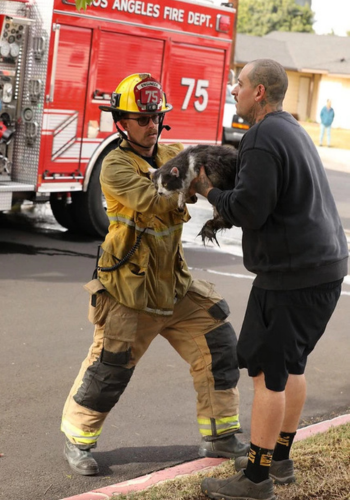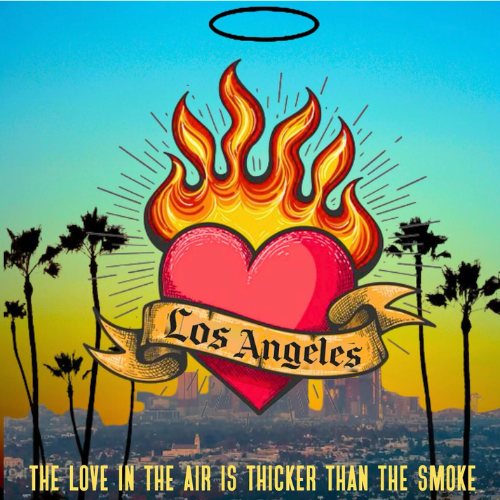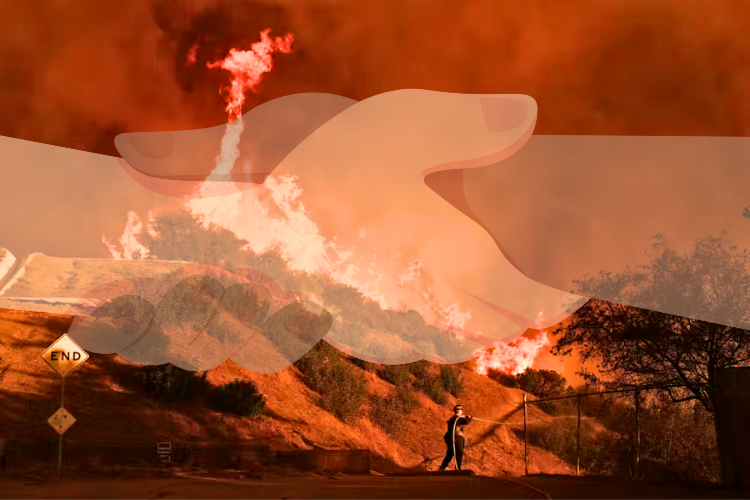By Michaela Haas, Reasons to Be Cheerful
Edited by Renata Hill, Moodfuel
On the streets of L.A., Michelin-starred chefs are cooking for firefighters, boutiques are giving away clothes and a sprawling city is coming together
Within 48 hours of her high school burning down and her family’s evacuation from Pasadena, 14-year-old Avery Colvert began building an impromptu “shopping center.”
In a large, white warehouse, she started stocking clothes for the teenage survivors of the Eaton Fire that scorched her neighborhood. Colvert and her stepdad, Matt Chait, quickly created an Instagram page, Altadena Girls, to solicit clothing donations.
Soon, dozens of people were showing up with bags of shirts and shoes. Fueled by posts from Paris Hilton and Charli XCX, her warehouse is now a bustling community center where displaced teenage fire victims replace the clothes they’ve lost, free of charge.
“No money, no nothing,” she advises her followers, because as a minor, she can’t legally take cash donations. Chic donations arrive from designers and boutiques. Dozens of people show up every day to help.
“I had never met these people in my life,” Colvert told Time. “It’s great.”
After posting that she needed clothing racks and boxes, “within 30 to 35 minutes, people are coming in with all the things we need. It’s insane.”

Reel from the Altadena Girls' Instagram account.
To a tourist, Los Angeles might look like a giant metropolis sprawling with interchangeable concrete spaces, but L.A. neighborhoods are communities. We know each other. We greet our neighbors. We watch each other’s pooches. Since the first fires began to ignite last Tuesday, the vital importance of those informal, community networks has become increasingly clear.
Within hours of the Palisades fire hitting the news, the first text messages pinged in: “Are you okay?“ My family had just moved out of the Los Angeles area on New Year’s Eve, eight days before the fires would decimate my former neighborhood. Our two-bedroom rental apartment is now occupied by a neighbor whose house burned down with all his possessions inside.
I sent my own flurry of messages to friends in the evacuation zones: “How can I help? Do you need a place to crash?”
We know 19 families who lost their homes, plus two still waiting to hear if their houses withstood the assault. At least 24 people have died in the infernos that have blazed through 40,000 acres of Los Angeles County. It’s the worst catastrophe to hit California in decades and likely the costliest ever, but for Californians, the cost is measured not just in lives lost and houses charred. Every time a piece of our beloved city burns, it takes an emotional and mental toll that cannot be quantified in trauma yards and grief dollars.
In the 15 years I lived in the Los Angeles area, I was told to evacuate three times.
In Malibu, we survived the 2018 Woolsey fire, which came within 50 feet of our house. Naively, I defied the evacuation orders, hosing down my landlord’s wood structure with the garden hose. Nothing could have prepared me for the full brunt of the flames and gusts. As if standing in a gigantic blow-dryer, the wet cloth I tied to my face dried within seconds. So the next two times I got out at the first warning, joining hundreds of others stuck in gridlock. The biting smoke immediately brings back the memories of agitation and fear.
This time, “Are you okay?” has become a challenging question to answer. Physically, yes, we are safe, about 40 miles south of the blaze, but the Santa Ana winds are blowing here, too, and our sense of safety shifts with the wind.
Mister Rogers famously said that his mother would tell him, “Look for the helpers. You will always find people who are helping.” What fills my heart in the face of destruction are the thousands of eager helpers.
Some firefighters are pulling double and triple shifts, but it’s not just the professionals who work beyond exhaustion. Mister Rogers would be encouraged by the long lines of helpers gathering at animal shelters, community centers, grassroots organizations and churches. At the Pasadena Community Job Center, hundreds of volunteers lined up to help clear debris and distribute supplies.
Chef José Andrés was on the streets of Pacific Palisades doling out food to first responders and displaced residents. His nonprofit, World Central Kitchen, feeds those suffering around the world, from Palestine to Ukraine, but when catastrophe visited his own backyard, he mobilized his volunteers. “Sandwiches, fruit, water — these guys need to drink!,” he said in an Instagram reel, surrounded by fire trucks.

The Los Angeles Times compiled a list of at least 50 restaurants offering free food to first responders and evacuees. Clothing stores have opened their doors, posting, “Fire survivors, come in and take whatever you need.” The YMCA is offering free childcare. Bobbie, an organic baby formula manufacturer, is giving away its product.
Best Friends Animal Society pulled 90 cats and 41 dogs from local shelters to help free up space for four-legged survivors, and most of the shelter pets immediately went into foster homes because so many volunteers opened their homes.
Nurses, psychotherapists and veterinarians have jumped into action, but so have booksellers, truck drivers, teenagers and children. Stumble into All Power Books, a small Los Angeles bookstore, and you won’t find your favorite novel right now, but you will find N95 masks, food cans, blankets, toiletries and sleeping bags. Its owners transformed the bookstore into an emergency supply center, recognizing that its proximity to the 10 Freeway made it an ideal distribution hub. By Thursday afternoon, the bookstore was turning away donations because its storage capacity was maxed out. Los Angeles really is the city of angels.
Our “larger” neighbors are helping, too. Canadian Canadair CL-415 water bombers filled up in the Santa Monica Bay to drop water on the Palisades fire. Plus, 150 Mexican firefighters are working with their US peers along with highly trained Indigenous firefighters known as the Navajo Scouts.
A collage showing a heart aflame before palm trees is making the rounds on social media with the caption, “The love in the air is thicker than the smoke.”

We will need all the help we can get, not just in the immediate aftermath, but for months or years to come. A major disaster like this disrupts more than individuals’ lives. It upends our understanding of home and our desire to be spared from the ever-intensifying climate crisis.
Yet, it also shows our resilience as a community. We may need to rebuild with steel roofs and sprinklers — or, in certain places, we may not be able to rebuild at all — but what remains intact is our solidarity, our knowledge that we all inhabit the same fragile planet, and that we are only as strong as the bonds we form and the hands we hold.
Michaela Haas, Ph.D., is a contributing editor at Reasons to Be Cheerful. An award-winning author and solutions reporter, her recent books include Bouncing Forward: The Art and Science of Cultivating Resilience. Visit www.michaelahaas.com
This article was reprinted with permission from Reasons to Be Cheerful, a nonprofit online magazine that is a tonic for tumultuous times.



